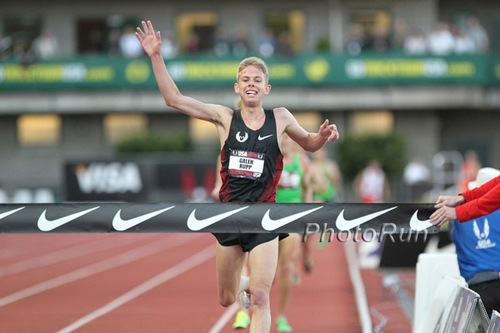 Galen Rupp, photo by PhotoRun.net
Galen Rupp, photo by PhotoRun.netUpdated December 27, 2016: This is the warmup and cooldown document for distance runners written by Roy Stevenson. Keep it in your training program and
We provided some suggestions for sprinters, jumpers, throwers, and now, distance runners, on their warm up and cool downs. Special thanks to American Track & Field writer Roy Stevenson, who has written for us for a few years now.
Here is his suggestions for distance runners:
Warming Up and Cooling Down for the Distance Events
By Roy Stevenson
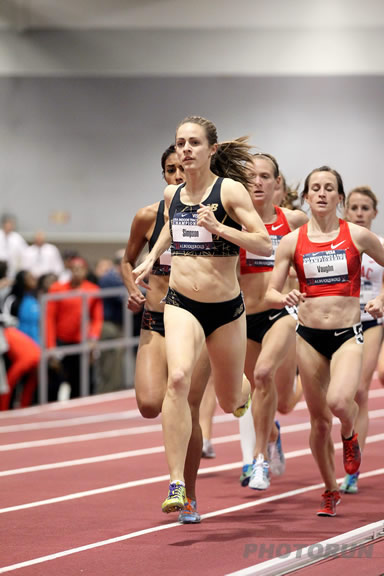 Jenny Simpson, photo by PhotoRun.net
Jenny Simpson, photo by PhotoRun.net
Distance runners need a solid warm-up to prepare physically and psychologically for their races and training sessions. The benefits of warming up include boosting the oxygen concentration in hemoglobin and increasing oxygen and blood flow to the working muscles. In addition, the warm up dilates the alveoli in our lungs, increases our heart rate, and facilitates the biochemical cascade in our muscles that enables us to tolerate more lactate and burn more free fatty acids as fuel.
 Bernard Lagat, photo by PhotoRun.net
Bernard Lagat, photo by PhotoRun.net
And if we time it right, the warm-up meshes our neuromuscular, skeletal, cardiovascular and respiratory systems, bringing about our “second wind”. Just as importantly, warming up helps nervous young athletes stabilize their adrenalin rush, helping them control their pre-race nervousness.
Research shows that for the standard high school distance events (800m, 1600m, 2-mile), warming up improves performance; but the intensity must be above 40% of VO2 max. Studies also show that if we wait longer than 10 minutes between the warm up and starting our race, we lose some of its benefits.
 Erica Moore, photo by PhotoRun.net
Erica Moore, photo by PhotoRun.netDistance runners should start their warm-up about 30 minutes before their event or training session. Phase one of the distance running warm up begins with 10-15 minutes of slow jogging to increase body temperature, increase muscle elasticity, and decrease blood viscosity.
Phase two immediately follows phase one: A 10-minute stretching session, starting with static stretches and progressing to dynamic and ballistic stretches through full range of motion, such as leg swinging. Distance runners should concentrate first on the calf, hamstring, and quadriceps muscles, and then the hips and groin area, with a few stretches for the upper body. Proceed as quickly as you can from static to dynamic stretching–research shows that static stretching may actually reduce the power and force of muscle contractions, not a condition that we want our runners to start their workout or race with!
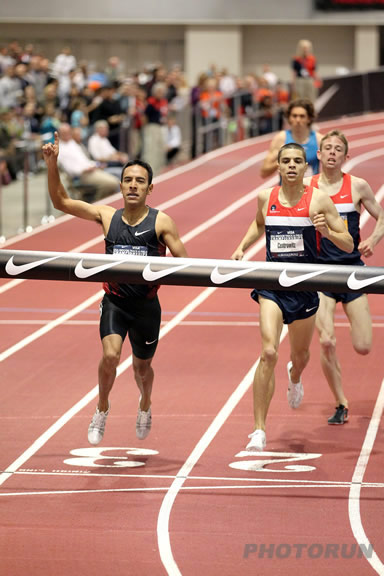 Leonel Manzano, Matt Centrowitz, Galen Rupp, photo by PhotoRun.net
Leonel Manzano, Matt Centrowitz, Galen Rupp, photo by PhotoRun.net
A warning here to coaches: the stretching phase of the warm up often takes far too long, negating the previous warm up effect, so keep it short, active, and sweet.
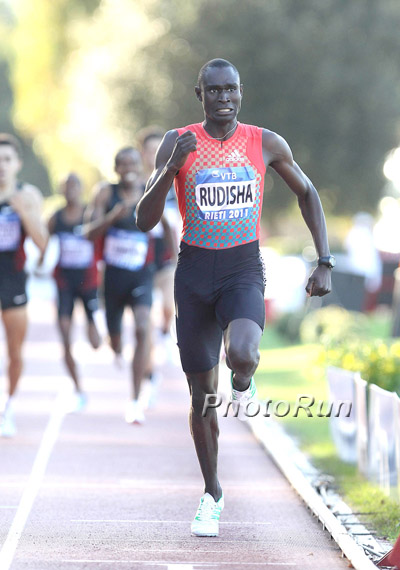 David Rudisha, photo by PhotoRun.net
David Rudisha, photo by PhotoRun.net
Once the runner is generally “limbered up”, it’s time for the third warm up phase, consisting of specific drills to put the finishing touches on the warm up. These usually include leg speed drills, and it is here that pre-race and pre-training warm ups diverge. The pre-race warm up needs a few (3-6) easy “acceleration stride throughs” over 50 meters, but no longer than this. This phase should finish 5 minutes before the race start, and all the runner needs to do until then is walk/jog to keep warm.
If the warm up precedes a workout, the runner can go through a series of 5-10 x 100 meter “acceleration stride throughs” where he focuses on correct running technique and staying relaxed while maintaining a fast leg turnover. These should be done with rolling starts, where the runner gradually picks up his pace after slow jogging for the first 10 meters. Each stride through should be a little faster than the previous one, with the final one being at about 95% of top speed.
 Ryan Hall, Meb Keflezighi, photo by PhotoRun.net
Ryan Hall, Meb Keflezighi, photo by PhotoRun.netAfter these faster efforts, many coaches have their runners do a series of drills ranging from sideways walking or running (aka carioca), backwards running, quick foot turnover in ladders and other ladder drills, cone running for agility, short high knee lift drills (walking or running), heel kick drills, lunge walking, calf walking, skipping, practice starts out to 20 meters, plyometrics, calisthenics like squat thrusts, short uphill sprints, downhill sprints, etc, you get the idea. There are whole books dedicated to these drills. It is not necessary to do all of these drills in every warm up–just do a few different ones in each warm up to keep it interesting and fun.
 Molly Huddle, photo by PhotoRun.net
Molly Huddle, photo by PhotoRun.net
Following this, some coaches integrate a longer interval in the third phase, usually consisting of one repetition of 600 meters to 1200 meters at around 75% to 85% of the athlete’s current best time for 800 meters.
Having completed these three phases, the distance runner is now ready for his main workout. The teenage distance runner’s total warm-up time should not exceed 35 minutes or a total of 3 miles–anything longer than this runs the risk of fatiguing, overheating, and dehydrating the runner, and depleting his glycogen stores.
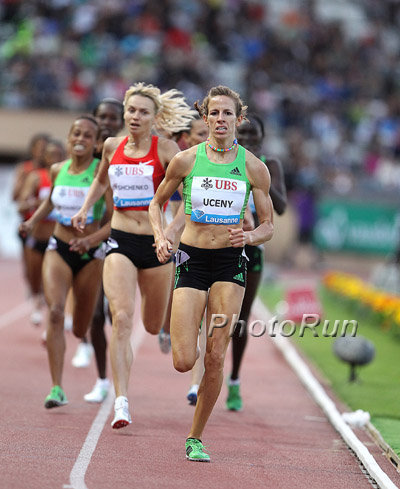 Morgan Uceny, photo by PhotoRun.net
Morgan Uceny, photo by PhotoRun.net
The key to a good warm up is to make sure your distance runners are ready to race without these side effects. One other warning: in hot or humid conditions, make sure your runners hydrate during the warm up with water or diluted electrolyte drink. They should avoid sugary soft drinks because of the risk of sugar spike followed by the inevitable blood sugar crash; and they can also make the runner feel sick during the race.
Other things to note about the warm up
If the temperature is very cold, a passive warm up, where external heating agents like hot tubs, hot water bottles, and hot showers are applied, can be highly effective, prior to going outside into an active warm up.
The cool down consists of an abbreviated warm up. i.e. An easy 5-10 minute jog followed by static stretching, and should not be neglected.
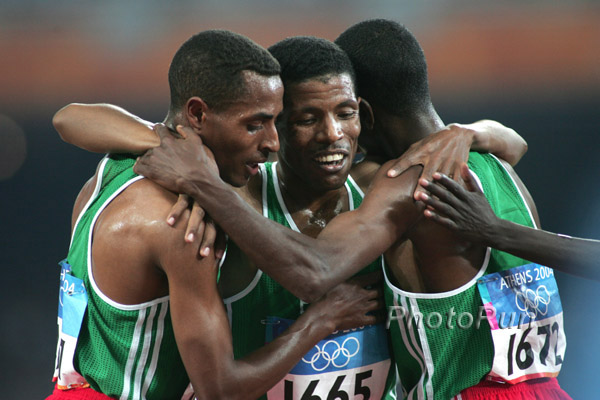 after the 10,000 meters, Athens 2004, photo by PhotoRun.net
after the 10,000 meters, Athens 2004, photo by PhotoRun.netFor more on coaching and the sport of track & field, coaches can receive free subs
for both CoachingAthletics Quarterly and American Track & Field. Just follow the clicks!
Author

Larry Eder has had a 52-year involvement in the sport of athletics. Larry has experienced the sport as an athlete, coach, magazine publisher, and now, journalist and blogger. His first article, on Don Bowden, America's first sub-4 minute miler, was published in RW in 1983. Larry has published several magazines on athletics, from American Athletics to the U.S. version of Spikes magazine. He currently manages the content and marketing development of the RunningNetwork, The Shoe Addicts, and RunBlogRun. Of RunBlogRun, his daily pilgrimage with the sport, Larry says: "I have to admit, I love traveling to far away meets, writing about the sport I love, and the athletes I respect, for my readers at runblogrun.com, the most of anything I have ever done, except, maybe running itself." Also does some updates for BBC Sports at key events, which he truly enjoys. Theme song: Greg Allman, " I'm no Angel."
View all posts




















